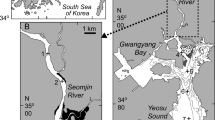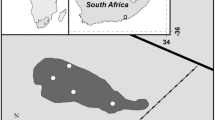Abstract
The Mattaponi River is part of the York River estuary in Chesapeake Bay. Our objective was to identify the organic matter (OM) sources fueling the lower food web in the tidal freshwater and oligohaline portions of the Mattaponi using the stable isotopes of carbon (C) and nitrogen (N). Over 3 years (2002–2004), we measured zooplankton densities and C and N stable isotope ratios during the spring zooplankton bloom. The river was characterized by a May–June zooplankton bloom numerically dominated by the calanoid copepod Eurytemora affinis and cladocera Bosmina freyi. Cluster analysis of the stable isotope data identified four distinct signatures within the lower food web: freshwater riverine, brackish water, benthic, and terrestrial. The stable isotope signatures of pelagic zooplankton, including E. affinis and B. freyi, were consistent with reliance on a mix of autochthonous and allochthonous OM, including OM derived from vascular plants and humic-rich sediments, whereas macroinvertebrates consistently utilized allochthonous OM. Based on a dual-isotope mixing model, reliance on autochthonous OM by pelagic zooplankton ranged from 20% to 95% of production, declining exponentially with increasing river discharge. The results imply that discharge plays an important role in regulating the energy sources utilized by pelagic zooplankton in the upper estuary. We hypothesize that this is so because during high discharge, particulate organic C loading to the upper estuary increased and phytoplankton biomass decreased, thereby decreasing phytoplankton availability to the food web.






Similar content being viewed by others
References
Acharya, K., P.A. Bukaveckas, J.D. Jack, M. Kyle, and J.J. Elser. 2006. Consumer growth linked to diet and RNA-P stoichiometry: response of Bosmina to variation in riverine food resources. Limnology and Oceanography 51: 1859–1869.
Adams, T.S., and R.W. Sterner. 2000. The effect of dietary nitrogen content on trophic level 15N enrichment. Limnology and Oceanography 45: 601–607.
Altabet, M.A. 1988. Variations in nitrogen isotopic composition between sinking and suspended particles: implications for nitrogen cycling and particle transformation in the open ocean. Deep Sea Research 35: 535–554.
Bilkovic, D.M., C.H. Hershner, and J.E. Olney. 2002. Macroscale assessment of American shad spawning and nursery habitats in the Mattaponi and Pamunkey rivers. North American Journal of Fisheries Management 22: 1176–1192.
Branco, A.B., and J.N. Kremer. 2005. The relative importance of chlorophyll and colored dissolved organic matter (CDOM) to the prediction of the diffuse attenuation coefficient in shallow estuaries. Estuaries 28: 643–652.
Brandl, Z. 2005. Copepods and rotifers: predators and their prey. Hydrobiologia 546: 475–489.
Caraco, N.F., G. Lampman, J.J. Cole, K.E. Limburg, M.L. Pace, and D. Fischer. 1998. Microbial assimilation of DIN in a nitrogen rich estuary: implications for food quality and isotope studies. Marine Ecology Progress Series 167: 59–71.
Carman, K.R., and D. Thistle. 1985. Microbial food partitioning by three species of benthic copepods. Marine Biology 88: 143–148.
Carpenter, S.R., J.J. Cole, M.L. Pace, M. Van de Bogert, D.L. Bade, D. Bastviken, C.M. Gille, J.R. Hodgson, J.F. Kitchell, and E.S. Kritzberg. 2005. Ecosystem subsidies: terrestrial support of aquatic food web from 13C addition to contrasting lakes. Ecology 86: 2737–2750.
Chanton, J., and F.G. Lewis. 2002. Examination of coupling between primary and secondary production in a river-dominated estuary: Apalachicola Bay, Florida, USA. Limnology and Oceanography 47: 683–697.
Cifuentes, L.A., J.H. Sharp, and M.L. Fogel. 1988. Stable carbon and nitrogen isotope biogeochemistry in the Delaware estuary. Limnology and Oceanography 33: 1102–1115.
Cloern, J.E., C. Grenz, and L. Vidergar-Lucas. 1995. An empirical model of the phytoplankton chlorophyll:carbon ratio—the conversion factor between productivity and growth rate. Limnology and Oceanography 40: 1313–1321.
Cloern, J.E., E.A. Canuel, and D. Harris. 2002. Stable carbon and nitrogen isotope composition of aquatic and terrestrial plants of the San Francisco Bay estuarine system. Limnology and Oceanography 47: 713–729.
Cole, J.J., and N.F. Caraco. 2001. Carbon in catchments: connecting terrestrial carbon losses with aquatic metabolism. Marine and Freshwater Research 52: 101–110.
Cole, J.J., S.R. Carpenter, M.L. Pace, M.C. Van de Bogert, J.L. Kitchell, and J.R. Hodgson. 2006. Differential support of lake food webs by three types of terrestrial organic carbon. Ecology Letters 9: 558–568.
Deegan, L.A., and R.H. Garritt. 1997. Evidence for spatial variability in estuarine food webs. Marine Ecology Progress Series 147: 31–47.
Escaravage, V., and K. Soetaert. 1995. Secondary production of the brackish copepod communities and their contribution to carbon fluxes in the Westerschelde estuary (The Netherlands). Hydrobiologia 311: 103–114.
Feuchtmayer, H., and J. Grey. 2003. Effect of preparation and preservation procedures on carbon and nitrogen stable isotope determinations from zooplankton. Rapid Communications in Mass Spectrometry 17: 2605–2610.
France, R.L. 1995. Differentiation between littoral and pelagic food webs in lakes using stable carbon isotopes. Limnology and Oceanography 40: 1310–1313.
Fry, B. 1991. Stable isotope diagrams of freshwater food webs. Ecology 72: 2293–2297.
Fry, B., and E. Sherr. 1984. d13C measurements as indicators of carbon flow in marine and freshwater ecosystems. Contributions in Marine Science 27: 13–47.
Hall, R.O., and J.L. Meyer. 1998. The trophic significance of bacteria in a detritus-based stream food web. Ecology 79: 1995–2012.
Hedges, J.I., W.A. Clark, P.D. Quay, J.E. Richey, A.H. Devol, U. de, and M. Santos. 1986. Compositions and fluxes of particulate organic material in the Amazon River. Limnology and Oceanography 31: 717–738.
Hoffman, J.C., and D.A. Bronk. 2006. Inter-annual variation in stable carbon and nitrogen isotope biogeochemistry of the Mattaponi River, Virginia. Limnology and Oceanography 51: 2319–2332.
Hoffman, J.C., D.A. Bronk, and J.E. Olney. 2007a. Contribution of allochthonous carbon to American shad production in the Mattaponi River, Virginia using stable isotopes. Estuaries and Coasts 30: 1034–1048.
Hoffman, J.C., D.A. Bronk, and J.E. Olney. 2007b. Tracking nursery habitat use by young American shad in the York River estuary, Virginia using stable isotopes. Transactions of the American Fisheries Society 136: 1285–1297.
Hughes, J.E., L.A. Deegan, B.J. Peterson, R.M. Holmes, and B. Fry. 2000. Nitrogen flow through the food web in the oligohaline zone of a New England estuary. Ecology 81: 433–452.
Huxel, G.R., K. McCann, and G.A. Polis. 2002. Effects of partitioning allochthonous and autochthonous resources on food web stability. Ecological Research 17: 419–432.
Jantz, P., S. Goetz, and C. Jantz. 2005. Urbanization and the loss of resource lands in the Chesapeake Bay watershed. Environmental Management 36: 808–825.
Jones, R.I. 1992. The influence of humic substances on lacustrine planktonic food chains. Hydrobiologia 229: 73–91.
Kerner, M., H. Hohenberg, S. Ertl, M. Reckermann, and A. Spitzy. 2003. Self-organization of dissolved organic matter to micelle-like microparticles in river water. Nature 422: 150–154.
Kerner, M., S. Ertl, and A. Spitzy. 2004. Trophic diversity within the planktonic food web of the Elbe Estuary determined on isolated individual species by 13C analysis. Journal of Plankton Research 26: 1039–1048.
Kimmel, D.G., W.D. Miller, and M.R. Roman. 2006. Regional scale climate forcing of mesozooplankton dynamics in Chesapeake Bay. Estuaries and Coasts 29: 375–387.
Mann, K.H. 1998. Production and use of detritus in various freshwater, estuarine, and coastal marine ecosystems. Limnology and Oceanography 33: 910–930.
Martinelli, L.A., M.C. Piccolo, A.R. Townsend, P.M. Vitousek, E. Cuevas, W. McDowell, G.P. Robertson, O.C. Santos, and K. Treseder. 1999. Nitrogen stable isotopic composition of leaves and soil: tropical versus temperate forests. Biogeochemistry 46: 45–65.
McCallister, L.S., J.E. Bauer, J.E. Cherrier, and H.W. Ducklow. 2004. Assessing sources and ages of organic matter supporting river and estuarine bacterial production: a multiple isotope (D14C, d13C, and d15N) approach. Limnology and Oceanography 49: 1687–1702.
McClelland, J.W., I. Valiela, and R.H. Michener. 1997. Nitrogen-stable isotope signatures in estuarine food webs: a record of increasing urbanization in coastal watersheds. Limnology and Oceanography 42: 930–937.
Meyer, J.L., and R.T. Edwards. 1990. Ecosystem metabolism and turnover of organic carbon along a blackwater river continuum. Ecology 71: 668–677.
Mook, W.G., and F.C. Tan. 1991. Stable carbon isotopes in rivers and estuaries. In Biogeochemistry of major world rivers, eds. E.T. Degens, S. Kempe, and J.E. Richy, 245–264. New York: Wiley.
Park, G.S., and H.G. Marshall. 2000. The trophic contributions of rotifers in tidal freshwater and estuarine habitats. Estuarine, Coastal and Shelf Science 51: 729–742.
Peterson, B.J., and B. Fry. 1987. Stable isotopes in ecosystem studies. Annual Review of Ecology and Systematics 18: 293–320.
Phillips, D.L., and J.W. Gregg. 2001. Uncertainty in source partitioning using stable isotopes. Oecologia 127: 171–179.
Raymond, P.A., and J.E. Bauer. 2001. DOC cycling in a temperature estuary: a mass balance approach using natural 14C and 13C isotopes. Limnology and Oceanography 46: 655–667.
Reaugh, M.L., M.R. Roman, and D.K. Stoecker. 2007. Changes in plankton community structure and function in response to variable freshwater flow in two tributaries of the Chesapeake Bay. Estuaries and Coasts 30: 403–417.
Shen, J., and L. Haas. 2004. Calculating age and residence time in the tidal York River using three-dimensional model experiments. Estuarine, Coastal and Shelf Science 61: 449–461.
Sin, Y., R.L. Wetzel, and I.C. Anderson. 1999. Spatial and temporal characteristics of nutrient and phytoplankton dynamics in the York River estuary, Virginia: analyses of long-term data. Estuaries 22: 260–275.
Smith, D.G. 2001. Pennak’s freshwater invertebrates of the United States: Porifera to Crustacea. 4New York: Wiley.
Sobczak, W.V., J.E. Cloern, A.D. Jassby, B.E. Cole, T.S. Schraga, and A. Arnsberg. 2005. Detritus fuels ecosystem metabolism but not metazoan food webs in San Francisco Estuary’s freshwater delta. Estuaries 28: 124–137.
Sun, L., E.M. Perdue, J.L. Meyer, and J. Weis. 1997. Use of elemental composition to predict bioavailability of dissolved organic matter in a Georgia river. Limnology and Oceanography 42: 714–721.
Tackx, M.L.M., N. de Pauw, R. Van Miegham, F. Azémar, A. Hannouti, S. Van Damme, F. Fiers, N. Daro, and P. Meire. 2004. Zooplankton in the Schelde estuary, Belgium and The Netherlands. Spatial and temporal patterns. Journal of Plankton Research 26: 133–141.
Vander Zanden, M.J., and J.B. Rasmussen. 2001. Variation in d15N and d13C trophic fractionation: Implications for aquatic food web studies. Limnology and Oceanography 46: 2061–2066.
Vannote, R.L., G.W. Minshall, K.W. Cummins, J.R. Sedell, and C.E. Cushing. 1980. The river continuum concept. Canadian Journal of Fisheries and Aquatic Sciences 37: 130–137.
Wallace, J.B., S.L. Eggert, J.L. Meyer, and J.R. Webster. 1997. Multiple trophic levels of a forest stream linked to terrestrial litter inputs. Science 277: 102–104.
Williamson, C.E. 1983. Invertebrate predation on planktonic rotifers. Hydrobiologia 104: 385–39.
Acknowledgements
We thank Deborah Steinberg, Michael Sierszen, John Morrice, and two anonymous reviewers for helpful comments on the manuscript; Brian Watkins, Patricia Crewe, Kristen Delano, Ashleigh Rhea, and Demetria Christo for field assistance; and Demetria Christo, Melanie Chattin, and David Harris for preparation and analysis of stable isotope samples. This work was supported by a National Science Foundation Graduate Research Fellowship to J. C. Hoffman and sponsored in part by NOAA Office of Sea Grant, US Department of Commerce, under Grant NA03OAR4170084 to the Virginia Graduate Marine Science Consortium and Virginia Sea Grant College Program, with additional support from the Wallop–Breaux program of the US Fish and Wildlife Service through the Marine Recreational Fishing Advisory Board of the Virginia Marine Resources Commission (Grants F-116-R-6 and 7). This is contribution of the Virginia Institute of Marine Science, The College of William and Mary.
Author information
Authors and Affiliations
Corresponding author
Rights and permissions
About this article
Cite this article
Hoffman, J.C., Bronk, D.A. & Olney, J.E. Organic Matter Sources Supporting Lower Food Web Production in the Tidal Freshwater Portion of the York River Estuary, Virginia. Estuaries and Coasts 31, 898–911 (2008). https://doi.org/10.1007/s12237-008-9073-4
Received:
Revised:
Accepted:
Published:
Issue Date:
DOI: https://doi.org/10.1007/s12237-008-9073-4




